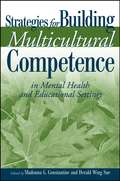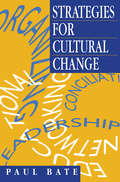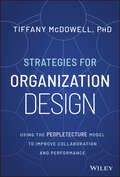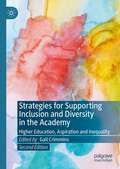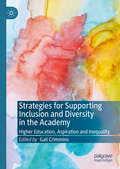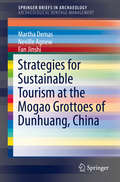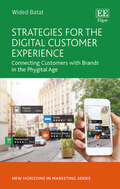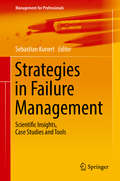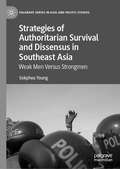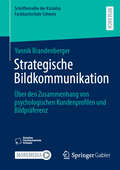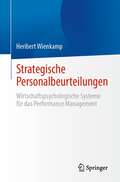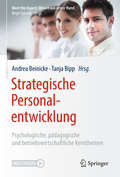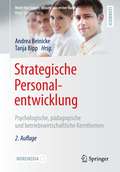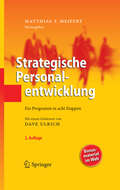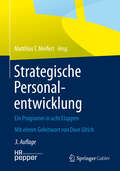- Table View
- List View
Strategies for Asia-Pacific Shipping (Routledge Revivals)
by Jeff Hawkins Richard GrayThis title was first published in 2000. This text focuses on one geographical and economical area - the Asia-Pacific region, on one type of decision makers - commercial shipowners, and on one type of business strategy - corporate level strategy, to show economic change and how organizations manage that change. This book discusses the challenges that shipowners face to take advantage of that growth. It also looks at the lack of information on strategic decision making that could assist the shipowners in taking advantage of the economic situation. The chapters cover the types of business strategies available and how to select the criteria for selecting one of those strategies.
Strategies for Building Multicultural Competence in Mental Health and Educational Settings
by Madonna G. Constantine Derald Wing Sue"A must-read book for all mental health professionals wanting to keep up with today's most important clients...practical, concrete, hands-on details from firsthand experts on ethnic populations." --Richard Suinn, PhD, Colorado State University, Past president (1999), American Psychological Association The rich mosaic of racial and ethnic diversity defines our society now more than ever. For students and professional psychologists, this translates into a critical need to address a range of cultural diversity issues, as well as potential biases. Recently, the American Psychological Association (APA) recognized the importance of cultural competence for psychologists through its adoption of its Multicultural Guidelines. Applying those guidelines to real-world practice is both complex and challenging. Only one text brings it all into sharp focus: Strategies for Building Multicultural Competence in Mental Health and Educational Settings. Edited and written by renowned multicultural experts, this informative guide is full of concrete strategies and case examples, all geared toward achieving the goal of culturally competent practice. Chapter by chapter, it uses a variety of practice modalities in various settings to help all mental health professionals increase their familiarity and compliance with the APA Multicultural Guidelines. Beginning with a useful summary of the APA guidelines, Strategies for Building Multicultural Competence in Mental Health and Educational Settings covers the guidelines' relevance to: * Individual and group counseling * Couples and family counseling * Career counseling with people of color * Independent practice settings * Multicultural consultations and organizational change * Academic mental health training settings * Clinical and hospital settings * College counseling center settings * Elementary and secondary school settings This timely reference also considers building multicultural competence around indigenous healing practices; in clinical supervision contexts; and in culturally sensitive research. Taken together, the book is a much-needed blueprint for making culturally informed decisions, explaining how the multicultural initiatives you implement today can he'p shape the field's future.
Strategies For Conducting Technology Assessments
by Joe E. Armstrong Willis W. HarmanUsing reviews of special reports and personal interviews with team members of recent National Science Foundation-sponsored assessments, the authors have assembled an eight-step functional strategy for conducting technology assessments. The steps are set within a framework that embodies the three key elements of all assessments: technology descripti
Strategies For Conducting Technology Assessments
by Joe E. Armstrong Willis W. HarmanUsing reviews of special reports and personal interviews with team members of recent National Science Foundation-sponsored assessments, the authors have assembled an eight-step functional strategy for conducting technology assessments. The steps are set within a framework that embodies the three key elements of all assessments: technology descripti
Strategies for Cultural Change
by Paul BateStrategies for Cultural Change develops a conceptual framework for thinking about cultural change. Starting with a discussion of the vocabulary (the concepts) of cultural change, the book moves on to the grammar (the thinking structures), and finally the ""oral"" practice (the applications) of cultural change in the organizational setting. Four main questions are addressed: Why change culture? Is planned cultural change possible? What kind of cultural change is envisaged? How does cultural change occur? The book contains 14 chapters organized into two parts. Part One examines the different types of cultural change strategy in some depth. ""Developmental"" and ""transformational"" strategies are then brought together into a single conceptual framework for cultural change. Part Two shifts from strategy to implementation; from thinking frameworks to frameworks for action. It begins by surveying current practice and examines the various, often strikingly different, ways in which people seek to effect cultural change in their organizations. Accounts are presented based both on the author's own first-hand experiences of working with private and public sector companies on cultural change programs, and on an extensive review of the available literature.
Strategies for Longevity in Family Firms: A European Perspective (Bocconi on Management)
by G. Corbetta Carlo SalvatoThe strategic concepts and tools illustrated in this book provide a framework for devising and implementing strategies favouring longevity of family-controlled business entities. The authors illustrate their arguments with examples drawn from their direct knowledge of representative Italian and European family firms.
Strategies for Organization Design: Using the Peopletecture Model to Improve Collaboration and Performance
by Tiffany McDowellDesign better organizations with humans at the center In Strategies for Organization Design: Using the Peopletecture Model to Improve Collaboration and Performance, EY’s People Advisory Principal, Dr. Tiffany McDowell, delivers an insightful exploration of organization design. Dr. McDowell combines expertise in both applied management and psychology to solve stubborn company challenges with practical solutions. Readers will have the opportunity to apply these solutions immediately to create positive impact, deal with rapid change, and consistently innovate at scale. In the book, you’ll learn to: Accelerate organizational transformation in a data-driven and evidence-based way Make your organization’s work mean and matter more to the people doing it Use insights drawn from network science, human motivation, behavioral economics, and organization theory to drive meaningful collaborationA groundbreaking, yet accessible new approach to building an exciting, innovative, and future-proofed organization, Strategies for Organization Design deserves a place in the hands of managers, executives, and other business leaders—as well as the consultants and specialists who serve them and their companies—who are looking for hands-on solutions twenty-first century business challenges.
Strategies for Organization Design: Using the Peopletecture Model to Improve Collaboration and Performance
by Tiffany McDowellDesign better organizations with humans at the center In Strategies for Organization Design: Using the Peopletecture Model to Improve Collaboration and Performance, EY’s People Advisory Principal, Dr. Tiffany McDowell, delivers an insightful exploration of organization design. Dr. McDowell combines expertise in both applied management and psychology to solve stubborn company challenges with practical solutions. Readers will have the opportunity to apply these solutions immediately to create positive impact, deal with rapid change, and consistently innovate at scale. In the book, you’ll learn to: Accelerate organizational transformation in a data-driven and evidence-based way Make your organization’s work mean and matter more to the people doing it Use insights drawn from network science, human motivation, behavioral economics, and organization theory to drive meaningful collaborationA groundbreaking, yet accessible new approach to building an exciting, innovative, and future-proofed organization, Strategies for Organization Design deserves a place in the hands of managers, executives, and other business leaders—as well as the consultants and specialists who serve them and their companies—who are looking for hands-on solutions twenty-first century business challenges.
Strategies for Supporting Inclusion and Diversity in the Academy: Higher Education, Aspiration and Inequality
by Gail CrimminsThis book explores tried and tested strategies that support student and faculty engagement and inclusion in the academy. These strategies are anchored by a brief exploration of the history and effect/s of exclusion and deprivilege in higher education. However, while many publications exploring academic inequality focus on the causes and impacts of structural, psychological and cultural exclusion based on racism, sexism, classism and ableism, they rarely engage in interventions to expose and combat such de/privilege. Capturing examples of inclusive practices that are as diverse as student and faculty populations, these strategies can be easily translated and employed by organisations, collectives and individuals to recognise and combat social and academic exclusion within higher education environments.
Strategies for Supporting Inclusion and Diversity in the Academy: Higher Education, Aspiration and Inequality
by Gail CrimminsThis book explores tried and tested strategies that support student and faculty engagement and inclusion in the academy. These strategies are anchored by a brief exploration of the history and effect/s of exclusion and deprivilege in higher education. However, while many publications exploring academic inequality focus on the causes and impacts of structural, psychological and cultural exclusion based on racism, sexism, classism and ableism, they rarely engage in interventions to expose and combat such de/privilege. Capturing examples of inclusive practices that are as diverse as student and faculty populations, these strategies can be easily translated and employed by organisations, collectives and individuals to recognise and combat social and academic exclusion within higher education environments.
Strategies for Sustainable Tourism at the Mogao Grottoes of Dunhuang, China (SpringerBriefs in Archaeology)
by Martha Demas Neville Agnew Jinshi FanAt the Mogao Grottoes, a World Heritage site near Dunhuang city in Gansu Province, visitor numbers have increased inexorably since 1979 when the site opened. A national policy that identifies tourism as a pillar industry, along with pressure from local authorities and businesses to encourage more tourism, threatens to lead to an unsustainable situation for management, an unsafe and uncomfortable experience for visitors and irreparable damage to the fragile art of the cave temples for which the site is famous. In the context of the comprehensive visitor management plan developed for the Mogao Grottoes, a multi-year study began in 2001 as a joint undertaking of the Dunhuang Academy and the Getty Conservation Institute to determine the impact of visitation on the painted caves and develop strategies for sustainable visitation such that, once implemented, these threats would be resolved. The methodological framework featured a major research and assessment component that integrates visitor studies; laboratory investigations; environmental monitoring; field testing and condition assessment to address the issues affecting the grottoes and visitors. Results from this component led to defining limiting conditions, which were the basis for establishing a visitor capacity policy for the grottoes and developing long-term monitoring and management tools.
Strategies for the Digital Customer Experience: Connecting Customers with Brands in the Phygital Age (New Horizons in Marketing series)
by Wided BatatOffering a critical approach to digital marketing strategies, this innovative book introduces the ‘phygital’, a new ecosystem that creates a continuum between physical and digital settings to aid the design of successful customer experiences. Combining theory with practical case studies, it provides a timely prediction of the evolution of customer experience and effective means of brand communication in an increasingly phygital era.Delineating how digital and physical experiences differ, this book characterizes the role of digital, AI, and extended reality technologies in creating successful and engaging phygital experiences and the customer values they engender. Chapters identify the underlying mechanisms for designing a compelling phygital customer experience and how it is enhanced by digital tools, devices, immersive technologies, chatbots, AI, and robotics. The book concludes by addressing how these technologies can help businesses create the ultimate brand experience in a phygital-driven context by rethinking their strategies and tools.Providing new market research tools and frameworks to better understand digital transformation, this book will prove vital to practitioners, students, and marketing scholars. Advising how to design compelling customer experiences that connect physical and digital settings, it will also prove a valuable resource to a vast range of businesses and consultants.
Strategies for Work with Involuntary Clients (PDF)
by Ronald H. RooneyInvoluntary clients are required to see a professional, such as juveniles on probation, or are pressured to seek help, such as alcoholics threatened with the desertion of a spouse. For close to two decades, Strategies for Work with Involuntary Clients has led in its honest analysis of the involuntary transaction, suggesting the kind of effective legal and ethical intervention that can lead to more cooperative encounters, successful contracts, and less burnout on both sides of the treatment relationship. For this second edition, Ronald H. Rooney has invited experts to address recent theories and provide new information on the best practices for specific populations and settings. He also adds practical examples and questions to each chapter to better facilitate the involvement of students and readers, plus a section on motivational interviewing.
Strategies in Failure Management: Scientific Insights, Case Studies and Tools (Management for Professionals)
by Sebastian KunertThis book offers a comprehensive overview of failure in business, management and consulting. It features contributions by experts from diverse fields, who share unique insights from their real-life experiences. Readers will find perspectives from leadership, project management, change management, innovation management, human resource management, counseling, restructuring, entrepreneurship and sports. Each chapter combines the latest empirical findings with relevant case studies, making for a unique book that offers a fascinating exploration of the largely unexplored area of setbacks, pitfalls, flops and disappointments in the business world.
Strategies of Authoritarian Survival and Dissensus in Southeast Asia: Weak Men Versus Strongmen (Palgrave Series in Asia and Pacific Studies)
by Sokphea YoungThis book analyses how authoritarian rulers of Southeast Asian countries maintain their durability in office, and, in this context, explains why some movements of civil society organizations succeed while others fail to achieve their demands. It discusses the relationship between the state-society-business in the political survival context. As the first comparative analysis of strategies of regime survival across Southeast Asia, this book also provides an in-depth insight into the various opposition movements, and the behaviour of antagonistic civic and political actors in the region.
Strategies of Identity Formation: Youth of Turkish Descent in Germany (VS College)
by Ali MehdiIntegration of immigrants and their descendants has been a socially sensitive and a politically pressing issue in Germany, particularly in recent decades. Being the largest immigrant group in the country, and for a number of other reasons, the spotlight has been on people of Turkish descent. From a sociological perspective, the process of identity formation is a critical step in the direction of integration. If immigrants of Turkish descent are to be integrated in the society, it is crucial to inquire how they conceive of themselves, and perceive how they are conceived by the so-called locals. Heeding Goethe, Ali Mehdi goes out into broad and open land to conduct in-depth interviews with seven young men of Turkish descent, born in Germany, and to analyze – utilizing the empathetic approach of the German hermeneutic tradition – the rich diversity of identity strategies that the interviewees employ.
Strategische Bildkommunikation: Über den Zusammenhang von psychologischen Kundenprofilen und Bildpräferenz (Schriftenreihe der Kalaidos Fachhochschule Schweiz)
by Yannik BrandenbergerIn einer sich rasant verändernden Marketinglandschaft wird die Bedeutung einer authentischen Verbindung zwischen Unternehmen und Konsumenten immer dringlicher. Statt mit Inhalten zu überfluten, liegt die Herausforderung darin, durch gezielte visuelle Kommunikation eine tiefere Bindung aufzubauen. Diese Herausforderung wird besonders in der fehlenden Anpassung von Bildern an die psychologischen Profile der Zielgruppe deutlich, für die bisher kein empirisch validiertes Modell existiert. In diesem Buch wird ein tiefer Einblick in den Zusammenhang zwischen psychologischen Kundenprofilen und Bildpräferenzen durch die Untersuchung und Weiterentwicklung des EIC-Modells gewonnen. Die empirischen Ergebnisse, gewonnen aus einer Studie mit 95 Teilnehmenden, bestätigen diese Verbindung und eröffnen neue Perspektiven für die strategische Bildkommunikation. Als Resultat dieser Forschung präsentiert sich das ICS-Modell – ein Instrument, das Fotograf*innen und Marketingexpert*innen befähigt, die Bildkommunikation gezielt auf Zielgruppen auszurichten. Dieses Buch bietet nicht nur einen Einblick in die theoretischen Grundlagen, es regt auch dazu an, wie diese Erkenntnisse in der Praxis für eine wirkungsvolle visuelle Kommunikation genutzt werden können.
Strategische Interaktion in der Haushaltspolitik: Advokaten, Kassenwarte und Regierungschefs in parlamentarischen Systemen
by Bernd LuigIn parlamentarischen Regierungssystemen stehen bei haushaltspolitischen Konflikten auf der einen Seite die Ausgabenminister. In ihren Geschäftsbereichen spielen die Ausgaben eine merklich größere Rolle als die Einnahmen. Sie besitzen daher unabhängig vom Umweltzustand ihrer Geschäftsbereiche den Anreiz, stets ein größeres Budget einzufordern. Ihnen gegenüber stehen mit einem politikbereichsübergreifenden Interesse der Finanzminister und der Regierungschef. Während der Finanzminister üblicherweise der Rationalität des Haushaltsausgleichs folgt, orientiert sich aber letzterer vermutlich am Erfolg der gesamten Regierungsarbeit. In diesem Buch wird nunmehr das Handeln von jedem Ausgabenminister, des als Kassenwart erscheinenden Finanzministers und des Regierungschefs modelliert. Im Mittelpunkt der Arbeit steht dabei die Forschungsfrage, inwieweit die Interaktion der drei Akteure die bereichsspezifischen Ausgaben in den Budgets der deutschen Länder beeinflusst.
Strategische Kommunikation von Gewerkschaften: Die Kampagnen Samstags gehört Vati mir, 35-Stunden-Woche und Mindestlohn
by Sascha Kristin FuthSascha Kristin Futh untersucht anhand von drei zeitgeschichtlich bedeutenden Kampagnen zum ersten Mal vergleichend die strategische Kommunikation von Gewerkschaften. Sie analysiert die Bedingungen, unter denen die Gewerkschaften ihren Einfluss über Kampagnen-Kommunikation geltend machten und stellt im Vergleich die ausschlaggebenden Faktoren für die gewerkschaftliche Kampagnenfähigkeit heraus. Die Verknüpfung von Kampagnen und tarifpolitischen Verhandlungen ist dabei ein zentraler Erfolgsfaktor. Der Kampagnen-Vergleich zeigt, dass für die Handlungsfähigkeit der Gewerkschaften insbesondere die Aufstellung des gewerkschaftlichen Apparats entscheidend ist.
Strategische Personalbeurteilungen: Wirtschaftspsychologische Systeme für das Performance Management
by Heribert WienkampStrategische Personalbeurteilungen konzentrieren sich zum einen auf die Personen, die sich bereits im Unternehmen befinden und „Geld kosten“, zum anderen zielen sie im Rahmen des Performance Managements darauf ab, über eine Vielzahl karrierefördernder Maßnahmen die Beschäftigten nach Möglichkeit bis zum Ruhestand „bei Laune zu halten“ und an die Firma zu binden. Nur dann ist eine Amortisation aller Investitionen in die Personalentwicklung und die Erzielung einer maximalen „Bildungs-Rendite“ gewährleistet.Um die personalstrategischen Ziele zu erreichen, empfiehlt es sich, einerseits den Kommunikations- und Feedbackprozess durch eine „jobspezifische“ Mitarbeiterbeurteilung zu unterstützen und zu formalisieren, andererseits diesen Prozess der Mitarbeiterfürsorge und Beziehungspflege durch die Vorgesetzten von der Leistungshonorierung und der Karriereentwicklung als Aktivitäten des Personalmanagements zu trennen. Neben der Diskussion von sonstigen beurteilungsrelevanten Themen (z.B. Beurteilungssysteme oder Schulungen) soll auch der Frage nachgegangen werden, wie dem „Lernen und Entwickeln“ aus der Balance Score Card durch Mitarbeiterfeedback im Rahmen der Personalbeurteilung bei der Strategieumsetzung und Unternehmensentwicklung geholfen werden kann. Zum Inhalt Strategiebewertung mit Hilfe der Rückmeldung aus den Beurteilungsgesprächen,Vor- und Nachteile einer Differenzierung zwischen Mitarbeiter-Feedback bezogen auf die aktuelle Tätigkeit und karrierefördernden Maßnahmen, „Lernen und Entwickeln“ aus der Perspektive der Balance Score Card (BSC), Strategieumsetzung und Strategiebewertung, Details zum Beurteilungsgespräch und die Bedeutung der Selbstbeurteilung als Vorbereitung auf die Mitarbeiterbeurteilung …und vieles mehr.
Strategische Personalentwicklung: Psychologische, pädagogische und betriebswirtschaftliche Kernthemen (Meet the Expert: Wissen aus erster Hand)
by Andrea Beinicke Tanja BippIn diesem Buch beantworten führende Expertinnen und Experten aus den Bereichen der Psychologie, Erwachsenenbildung und Betriebswirtschaftslehre praxisbezogene relevante Fragen zur Thematik der beruflichen Weiterbildung in der heutigen Arbeitswelt. Sie erfahren mehr zum Thema Personalentwicklung im Wandel der Zeit, verschiedene Weiterbildungssettings und wie Weiterbildungsserfolge sichergestellt werden können. Sie erhalten auch wissenschaftlich fundierte Erkenntnisse über Coaching und Mentoring und weitere Kernthemen wie: - Wie wirkt sich die alternde Arbeitsgesellschaft auf die betriebliche Weiterbildung aus?- Wie stellt man den Erfolg von Trainingsmaßnahmen im Arbeitsalltag sicher, so dass sich Investitionen in solche Maßnahmen lohnen? - Wie können Führungskräfte ihre Mitarbeitenden dazu befähigen, notwendige Kompetenzen für das heutige und zukünftige Arbeitsleben zu entwickeln? - Ist Coaching von Mitarbeitenden effektiv oder können auch negative Effekte auftreten?Dieses Buch richtet sich an Professionals aus der Praxis, die im Bereich Human Resource Development tätig sind wie Personalverantwortliche, Personalentwickler, Personalleiter sowie Mitarbeitende aus Weiterbildungseinrichtungen. Aber auch Studierende, Lehrende, und Wissenschaftler und alle, die Interesse haben, sich mit aktuellen und zukunftsweisenden Fragen der Personalentwicklung zu beschäftigen, sind zur Lektüre eingeladen.
Strategische Personalentwicklung: Psychologische, pädagogische und betriebswirtschaftliche Kernthemen (Meet the Expert: Wissen aus erster Hand)
by Andrea Beinicke Tanja BippIn diesem Buch beantworten führende Expertinnen und Experten aus den Bereichen der Psychologie, Erwachsenenbildung und Betriebswirtschaftslehre praxisbezogene relevante Fragen zur Thematik der beruflichen Weiterbildung in der heutigen Arbeitswelt.Sie erfahren mehr zum Thema Personalentwicklung im Wandel der Zeit, verschiedene Weiterbildungssettings und wie Weiterbildungsserfolge sichergestellt werden können. Sie erhalten auch wissenschaftlich fundierte Erkenntnisse über Coaching und Mentoring und weitere Kernthemen wie:Wie wirkt sich die alternde Arbeitsgesellschaft auf die betriebliche Weiterbildung aus?Wie stellt man den Erfolg von Trainingsmaßnahmen im Arbeitsalltag sicher?Wie können Führungskräfte ihre Mitarbeitenden dazu befähigen, notwendige Kompetenzen für das heutige und zukünftige Arbeitsleben zu entwickeln?Ist Coaching von Mitarbeitern effektiv oder können negative Effekte auftreten?Dieses Buch richtet sich an Professionals aus der Praxis, die im Bereich Human Resource Development tätig sind wie Personalverantwortliche, Personalentwickler, Personalleiter sowie Mitarbeitende aus Weiterbildungseinrichtungen. Aber auch Studierende, Lehrende, und Wissenschaftler und alle, die Interesse haben, sich mit aktuellen und zukunftsweisenden Fragen der Personalentwicklung zu beschäftigen, sind zur Lektüre eingeladen.
Strategische Personalentwicklung: Ein Programm in acht Etappen
by Matthias T. MeifertPersonalentwickler in deutschen Unternehmen sehen sich einem starken Rechtfertigungsdruck ausgesetzt. Es geht dabei im Kern um die Frage, inwieweit die Personalentwicklung einen Wertschöpfungsbeitrag für das Unternehmen erbringt. Die Antwort darauf ist eine konsequente Orientierung aller Instrumente der Personalentwicklung an der Unternehmensstrategie. Das Buch stellt ein Programm in acht Etappen vor, mit dem eine strategische Personalentwicklung erfolgreich umgesetzt werden kann. Für die Neuauflage wurde der Anwendungsbezug weiter erhöht.
Strategische Personalentwicklung: Ein Programm in acht Etappen
by Dave Ulrich"In Zeiten, in denen nahezu jedes Unternehmen vor neuen und unerwarteten Herausforderungen steht, denkt wohl jeder, der in verantwortungsvoller Position tätig ist, über die Zukunft nach. Als Konsequenz entwickelt sich nicht nur in den großen, sondern zunehmend auch in mittleren und kleineren Unternehmen strategische Planung. Was aber helfen die überzeugendsten strategischen Konzepte, wenn den Mitarbeiterinnen und Mitarbeitern die Bereitschaft und die Fähigkeit fehlen, einen Plan umzusetzen? Es gilt also, die Mitarbeiter zu entwickeln, und zwar nicht für das, was heute ansteht, sondern für das, was morgen gefordert wird. Strategische Personalentwicklung wird daher für den künftigen Unternehmenserfolg zur kritischen Größe. Was dabei grundsätzlich zu bedenken und konkret zu tun ist, zeigt dieses von Matthias T. Meifert herausgegebene Werk. In einer schönen Systematik werden acht Etappen der Personalentwicklung dargestellt, erfolgskritische Faktoren beschrieben sowie Hinweise für die alltägliche strategische Personalentwicklungsarbeit im Unternehmen geschildertgegeben. (...) Wer also wissen möchte, was man unter strategischer Personalentwicklung versteht und dann nach konkreten Hinweisen sucht, wie er dieses Wissen im Unternehmen auch umsetzen kann, für den ist dieses Buch nahezu unverzichtbar." Prof. Dr. Dr. h. c. Lutz von Rosenstiel, Lehrstuhl für Organisations- und Wirtschaftspsychologie, Ludwig-Maximilians-Universität München
Strategische Personalentwicklung in der Praxis: Instrumente, Erfolgsmodelle, Checklisten, Praxisbeispiele
by Christine WegerichChristine Wegerich liefert eine umfassende und aktuelle Übersicht über die gängigen Methoden und Instrumente der strategischen Personalentwicklung. Unternehmen sind nur dann erfolgreich, wenn sie ihre Personalentwicklung auf die strategischen Ziele in ihren Märkten ausrichten. Die Autorin beschreibt den gesamten Personalentwicklungsprozess und präsentiert aktuelle Beispiele aus der Praxis. Checklisten und Expertenaussagen zeigen bewährte sowie innovative Konzepte und geben konkrete Handlungsempfehlungen für die Planung, Umsetzung und Evaluation.Für die 3. Auflage ist das Buch komplett aktualisiert und erweitert worden. Beispiele für den erfolgreichen Einsatz strategischer Personalentwicklung – unter anderem: AOK, Commerzbank, Novartis und TRUMPF – sowie neue Konzepte der beruflichen Erstausbildung werden detailliert vorgestellt.

